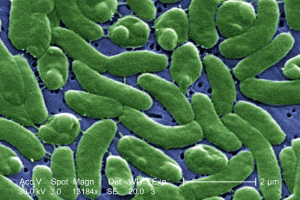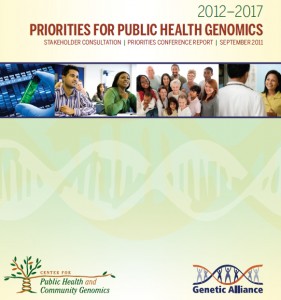Categories: genomics, heart disease
March 1st, 2012 3:06 pm ET -
Guest Blogger
Debra Duquette, MS, CGC, Genomics Coordinator & Beth Anderson, MPH, Genomics Epidemiologist, Michigan Department of Community Health
A Michigan Story on Lessons Learned and Action Steps to Take
The winter months have arrived and with them comes a certain madness, specifically March Madness. On March 12, 2012 the NCAA men’s college basketball tournament will commence. Most of the focus will be on cheering for the teams we picked to win our brackets; however, as Michigan learned last year, this isn’t the only thing we need to focus on.
 On March 3, 2011, with less than 30 seconds left in overtime in Fennville High School’s final regular season men’s basketball game, a winning layup was scored that brought Fennville’s team an undefeated record. With district playoffs in Fennville’s future, the gymnasium was full of celebration. Within moments, the crowd went silent as their star player collapsed to the ground. Wes Leonard, the player who had scored the winning basket moments before was now unconscious. Over 2,000 fans stood stunned, waiting for paramedics to arrive. Although an AED was present at the school, it was not charged and CPR was not performed because people did not think that cardiac arrest could be at fault in someone so young. Wes was later declared dead at a local hospital and the autopsy showed that he died of cardiac arrest due to an enlarged heart.
On March 3, 2011, with less than 30 seconds left in overtime in Fennville High School’s final regular season men’s basketball game, a winning layup was scored that brought Fennville’s team an undefeated record. With district playoffs in Fennville’s future, the gymnasium was full of celebration. Within moments, the crowd went silent as their star player collapsed to the ground. Wes Leonard, the player who had scored the winning basket moments before was now unconscious. Over 2,000 fans stood stunned, waiting for paramedics to arrive. Although an AED was present at the school, it was not charged and CPR was not performed because people did not think that cardiac arrest could be at fault in someone so young. Wes was later declared dead at a local hospital and the autopsy showed that he died of cardiac arrest due to an enlarged heart.
Sudden deaths of young athletes bring attention to an important public health problem known as sudden cardiac death of the young (SCDY), which occurs in non-athletes, too. On average, an estimated 66 athletes die suddenly of cardiac cause each year in the United States. Each year in Michigan alone, approximately 300 people aged 1-39 years die suddenly of a cardiac cause. Importantly, SCDY is known to have a strong hereditary component in many cases.
 5 Comments -
Read more
5 Comments -
Read more

Categories: family history, genomics
February 23rd, 2012 1:05 pm ET -
Muin J Khoury, Director, Office of Public Health Genomics, Centers for Disease Control and Prevention

When it comes to the use of genomic tests and technologies in practice, Dr Al Berg is a skeptic. Dr Berg is the founding chair of the CDC-sponsored Evaluation of Genomic Applications in Practice and Prevention (EGAPP) Working Group that has been evaluating genomic tests for more than 5 years. He also chaired the National Institutes of Health State-of-the-Science Conference on family history. The EGAPP group has recommended only one genomic test for use in clinical practice among a handful of tests they have assessed so far. The NIH conference found “insufficient evidence” for supporting systematic collection of family history in primary care. Since then, Dr Berg has repeatedly urged caution regarding claims that genetic tests and family history can improve health outcomes.
 3 Comments -
Read more
3 Comments -
Read more

Categories: genomics, whole genome sequence
January 12th, 2012 1:18 pm ET -
Marta Gwinn, Consultant, McKing Consulting Corp, Office of Public Health Genomics, Centers for Disease Control and Prevention

There was no cholera in Haiti until October 2010, when epidemic cholera swept the country. Within 6 months, more than 250,000 people were sickened and 4,000 died. A catastrophic earthquake earlier that year had exacerbated human and environmental risks by displacing millions of people and disrupting public health infrastructure. But there would have been no epidemic without the bacterium, Vibrio cholerae. How did the pathogen enter the picture?
 1 Comment -
Read more
1 Comment -
Read more

Categories: family history, genomics
December 15th, 2011 12:28 pm ET -
Guest Blogger
Ruta Sharangpani MD, MPH
Bureau of Disease Control Prevention and Epidemiology
Michigan Department of Community Health
Debra Duquette, MS, CGC
Genomics Coordinator
Michigan Department of Community Health
 During the holiday season, many of us will be watching our favorite holiday movies for the umpteenth time. Some of our favorites (according to Gayot, Moviefone and Yahoo are Home Alone, A Christmas Story, A Charlie Brown Christmas, and It’s a Wonderful Life. Most holiday movies seem to have relatives as central characters and family gatherings as a major theme. One of the reasons that holiday movies may be so popular is they remind us of our own wishes and fears.
During the holiday season, many of us will be watching our favorite holiday movies for the umpteenth time. Some of our favorites (according to Gayot, Moviefone and Yahoo are Home Alone, A Christmas Story, A Charlie Brown Christmas, and It’s a Wonderful Life. Most holiday movies seem to have relatives as central characters and family gatherings as a major theme. One of the reasons that holiday movies may be so popular is they remind us of our own wishes and fears.
 1 Comment -
Read more
1 Comment -
Read more

Categories: genomics
December 1st, 2011 12:35 pm ET -
Muin J Khoury, Director, Office of Public Health Genomics, Centers for Disease Control and Prevention
 In June 2011, the CDC Office of Public Health Genomics launched a community wide consultation process to develop priorities for the field of public health genomics in the next 5 years. This process was initiated as part of strategic visioning for integrating the emerging tools of genomics into practice and assuring the success of these new tools in improving population health. The process was conducted at a time of a widening gap between the rapid scientific advances in genomics and their impact on improving population health. The University of Michigan Center for Public Health and Community Genomics and Genetic Alliance spearheaded an effort to seek, collate and synthesize advice and recommendations from numerous stakeholders and constituents. The effort culminated in a workshop conducted on September 14, 2011 in Bethesda, Maryland. The results of the consultation, discussions and deliberations are summarized in a report published by the University of Michigan. Highlights of the recommendations are summarized here but readers should consult the full report. Some of the recommendations include:
In June 2011, the CDC Office of Public Health Genomics launched a community wide consultation process to develop priorities for the field of public health genomics in the next 5 years. This process was initiated as part of strategic visioning for integrating the emerging tools of genomics into practice and assuring the success of these new tools in improving population health. The process was conducted at a time of a widening gap between the rapid scientific advances in genomics and their impact on improving population health. The University of Michigan Center for Public Health and Community Genomics and Genetic Alliance spearheaded an effort to seek, collate and synthesize advice and recommendations from numerous stakeholders and constituents. The effort culminated in a workshop conducted on September 14, 2011 in Bethesda, Maryland. The results of the consultation, discussions and deliberations are summarized in a report published by the University of Michigan. Highlights of the recommendations are summarized here but readers should consult the full report. Some of the recommendations include:
 Post a Comment -
Read more
Post a Comment -
Read more

Categories: genomics, whole genome sequence
November 3rd, 2011 9:56 am ET -
Muin J Khoury, Director, Office of Public Health Genomics, Centers for Disease Control and Prevention

The popular proverbial saying “you cannot have your cake and eat it too” implies that one cannot consume something and preserve it at the same time–in other words, we cannot have it both ways. Well, for once, maybe we can have our cake–our whole genome sequence (WGS)–and eat it too. I believe having our WGS and consuming it in small bite sizes over a lifetime may be the only way to integrate it into medicine and public health.
Rapid advances in genomic sequencing technologies are making the possibility of reliable and affordable whole genome sequencing (WGS) a reality in the next few years. We all carry about 6 billion base pairs of DNA in each of our cells, with 5-10 million inherited variants that are different among us. This genetic variation along with environmental influences provides a blueprint for health throughout the life span, and is related to virtually every disease of public health significance. There is definite interest among the public and scientists about the personal utility of this information. In a recent survey by Nature, attitudes towards genome sequencing were explored among a sample dominated by scientists and professionals from medicine and public health. Although only 18.2% of respondents had had their genome sequenced or analyzed, 2/3 of those who had not reported they would take the opportunity should it arise. Curiosity was reported as the main single factor influencing respondents.
 4 Comments -
Read more
4 Comments -
Read more

Categories: family history, genomics, heart disease, stroke
October 13th, 2011 11:44 am ET -
Muin J Khoury, Director, Office of Public Health Genomics, Centers for Disease Control and Prevention

In September 2011, the US Department of Health and Human Services announced a new initiative to prevent 1 million heart attacks and strokes in the United States in the next 5 years. This campaign will implement proven, effective, and inexpensive interventions in both clinical and community settings. In clinical practice, it will improve management of the ABCS (aspirin use for high risk patients, blood pressure control, cholesterol management and smoking cessation). In community settings, it will enhance efforts to reduce smoking, improve nutrition and reduce high blood pressure.
 3 Comments -
Read more
3 Comments -
Read more

Categories: genomics, investigation
September 22nd, 2011 4:48 pm ET -
Marta Gwinn, Consultant, McKing Consulting Corp, Office of Public Health Genomics, Centers for Disease Control and Prevention

Contagion, catastrophe, even “zombie apocalypse”— whatever the threat, an all hazards approach goes a long way toward protecting individuals and communities. But besides delivering broad-spectrum medical and technical support, the public health system has to be ready to investigate. Public health sciences help keep “better safe than sorry” from becoming “better luck next time” by building the capacity to anticipate, detect, prevent, and respond to future threats. That’s the essence of preparedness—and genomics is part of the toolkit.
 Post a Comment -
Read more
Post a Comment -
Read more

Categories: family history, genomics, personal genomics
September 8th, 2011 3:03 pm ET -
Muin J Khoury, Director, Office of Public Health Genomics, Centers for Disease Control and Prevention

We thank our readers for their thoughtful comments on our recent post, which discussed the validity and utility of personal genomic tests for improving health. Clearly, this topic engenders a range of reactions as reflected in a recent scientific discussion. Several people I know have sought testing for various reasons, including curiosity, genealogic research, or just for fun. I’ve even been tempted a few times to be tested myself. However, when I looked at the scientific evidence for the accuracy, validity and utility of the information I would receive from such testing for the purpose of improving health and preventing future disease, I decided not to do it–at least not yet. I may change my mind in the future as the science matures. And of course, each person is free to make their own informed decision.
 1 Comment -
Read more
1 Comment -
Read more

Categories: family history, genomics, personal genomics
August 25th, 2011 12:08 pm ET -
Muin J Khoury, Director, Office of Public Health Genomics, Centers for Disease Control and Prevention

Campaigns against public spitting in the 19th century were largely driven by concerns about the spread of tuberculosis. However, at the beginning of the 21st century, spitting seems to be making a comeback. Over the past few years, several companies have begun offering personal genomic tests online to the public. There have been famous images of “spit parties”, where celebrities are seen filling tubes with saliva to ship for DNA testing. Getting information on one’s genes has been promoted as fun, as part of social networking, and as a basis for improving health and preventing disease.
 11 Comments -
Read more
11 Comments -
Read more

 On March 3, 2011, with less than 30 seconds left in overtime in Fennville High School’s final regular season men’s basketball game, a winning layup was scored that brought Fennville’s team an undefeated record. With district playoffs in Fennville’s future, the gymnasium was full of celebration. Within moments, the crowd went silent as their star player collapsed to the ground. Wes Leonard, the player who had scored the winning basket moments before was now unconscious. Over 2,000 fans stood stunned, waiting for paramedics to arrive. Although an AED was present at the school, it was not charged and CPR was not performed because people did not think that cardiac arrest could be at fault in someone so young. Wes was later declared dead at a local hospital and the autopsy showed that he died of cardiac arrest due to an enlarged heart.
On March 3, 2011, with less than 30 seconds left in overtime in Fennville High School’s final regular season men’s basketball game, a winning layup was scored that brought Fennville’s team an undefeated record. With district playoffs in Fennville’s future, the gymnasium was full of celebration. Within moments, the crowd went silent as their star player collapsed to the ground. Wes Leonard, the player who had scored the winning basket moments before was now unconscious. Over 2,000 fans stood stunned, waiting for paramedics to arrive. Although an AED was present at the school, it was not charged and CPR was not performed because people did not think that cardiac arrest could be at fault in someone so young. Wes was later declared dead at a local hospital and the autopsy showed that he died of cardiac arrest due to an enlarged heart.









